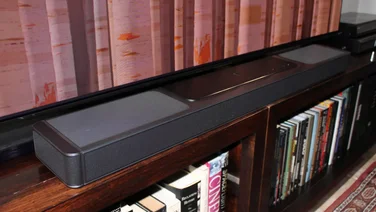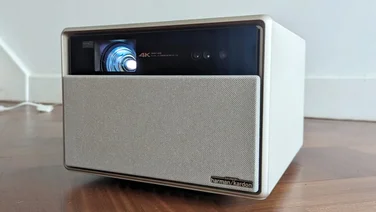To help us provide you with free impartial advice, we may earn a commission if you buy through links on our site. Learn more






- Simple and accessible UI
- Runs from a USB socket
- Good 4K picture and audio quality
- No Dolby Vision or Atmos support
- Lacks the extra features of the Fire TV platform
Roku’s new version of its classic Streaming Stick Plus comes in as an entry-level 4K streamer, designed to compete with the basic Amazon Fire TV Stick 4K as a low-cost upgrade for 4K TVs. Like the Amazon Fire TV Stick 4K, the Roku Stream Stick Plus (2025) provides a solid set of basic 4K HDR streaming capabilities from a slimline HDMI stick you can easily plug into your TV, although it shaves off a few premium features such as support for Dolby Vision or Dolby Atmos to keep the price down.
As with all Roku devices, it has the advantage of support for every major UK app and service, and it comes with a simple, clean user interface that makes it easy to find the TV shows or movies you want to watch. If you prefer a smart TV experience that’s free from pushy promotional content, Roku might be your best option – and the Streaming Stick Plus the ideal way to enjoy it.
Roku Streaming Stick Plus (2025) review: What you need to know
The Roku Streaming Stick Plus is a slimline streaming stick just 94mm long, 20mm wide and under 12mm thick, that plugs directly into a spare HDMI port on your 4K TV set.
Cleverly, Roku has designed it to take all its power from your one of your TV’s USB-A sockets, so there’s no need to plug in a separate power adapter and you won’t face the stability issues you’ll get when trying to do the same with an Amazon Fire TV Stick.






It can output at resolutions of 1080p to 2160p at 60fps, and it supports the HDR10+ and HLG HDR formats, while passing through Dolby Digital audio and DTS Digital Surround. It has a built-in dual-band Wi-Fi 5 radio for connecting to the Internet.
It comes with a compact but chunky remote, a little smaller than Amazon’s Alexa Voice Remote, complete with shortcut keys for Netflix, Disney+, Apple TV+ and Amazon Prime Video, not to mention a built-in microphone for voice search. The remote can also learn to turn your TV on and off or adjust and mute the volume.
Price and competition
The Streaming Stick Plus is great value at a mere £40 and at that price its most obvious competition comes from the Amazon Fire TV Stick 4K. At £60, it is £20 more expensive than the Roku, although it is frequently sold at a hefty discount during Amazon’s frequent sales events.
And that £20 does buy you some extra features, too, including support for Dolby Atmos audio, Dolby Vision HDR, and Wi-Fi 6. The latter may make a difference if you have your TV located in a bit of a Wi-Fi black spot in your house, allowing you to stream 4K content where a Wi-Fi 5 connection struggles.
Other rivals, like the Google TV Streamer (4K), Amazon Fire TV Stick 4K Max and Apple TV are even more expensive, and only worth the extra if you’re looking for a high-performance 4K streaming platform with more storage that can also run games and apps. The Roku Streaming Stick Plus is more limited on processing power and isn’t designed to handle that kind of thing.
Design
The Streaming Stick Plus is noticeably smaller than the 141 x 39 x 17.6mm Fire TV Stick 4K and a little easier to find space for on a cramped or busy panel full of HDMI sockets, which is good as there’s no extender cable provided. Instead, you get a short USB-C to USB-A power cable for powering the stick directly from your TV.
If your AV setup is anything like mine you’ll be pleased not to have to find space for yet another power supply, and the Streaming Stick Plus works flawlessly without one. I’ve occasionally used a Fire TV stick in this manner – against recommendations – but it’s not unusual to find it refuse to boot or crash out halfway through a movie.






Part of the reason the bundled remote is so compact, is that it hides its volume and mute controls on the right-hand edge. Not the most intuitive bit of design, perhaps, but the rocker-style design of the former makes it fairly easy to locate by touch. Otherwise, the remote is straightforward to use, with the all-important Back and Home buttons up top and a large purple D-Pad just below. One feature I particularly like is the dedicated “step back” button, which skips video playback back a few seconds when you miss something crucial.
Most importantly, Roku’s software is simple and accessible, with a homescreen that, instead of pushing bunch of recommendations at you, mostly consists of a grid of square tiles that whisk you directly to your favourite streaming apps and services. All the major UK streaming and catch-up services are represented, along with a collection of more esoteric apps from Europe, the US and elsewhere.
It’s also easy to set up. Once I’d selected my network and entered the password, all I needed to do was set the unit up with a Roku account using my smartphone. I also found I could sign on to nearly all my streaming services through my phone using QR codes, without the expected pain of entering login details using the remote and an onscreen keyboard.
Performance
Roku doesn’t provide any info on the processor or RAM in its streaming sticks, but generally performance is pretty good. In some streaming apps there’s the odd small delay while you’re browsing from show to show, particularly when there’s preview video involved, which I didn’t see with my Fire TV Stick 4K Max or the Google TV Streamer (4K).
However, it’s far from painful, and actually better than on the built-in apps on my LG OLED TV, which sometimes seem to go on holiday when navigating, say, the Amazon Prime Video home page.






TV shows and movies are also pretty quick to load and start streaming. Firing up John Wick 3 on Amazon Prime Video took 9.17 seconds versus 6.14 seconds on the Fire TV Stick 4K Max, but it matched the Amazon streamer when paying Squid Game on Netflix and Andor in Disney Plus.
Features and customisations are fairly limited, but that goes with Roku’s mission to keep things simple. You can still have your own colour themes and screensavers if you want. And while Roku’s voice search features are rudimentary compared to Amazon and Google’s, they focus on finding shows and movies and work pretty well in that context.
Sure, Roku failed my usual “find movies by the director of Guardians of the Galaxy” and “find films directed by Kevin Costner and starring Kevin Costner” tests, but Amazon and Google have yet to come up trumps there, either.
The Roku Streaming Stick Plus may not support Dolby Vision, but regular 4K HDR10+ and HLG content still looks great. In back-to-back tests across my LG TV’s built-in apps, the Amazon Fire TV Stick 4K Max and the Roku, I found the colour gradations were a touch smoother and the colours were ever so slightly more vibrant on the Fire TV Stick in certain scenes, but the difference isn’t night and day. If Dolby Vision is important to you, pay the extra for a device that supports it, but for most people spending £40 on a streaming stick to plug into an older budget or mid-range TV the Roku will serve perfectly well.
It’s a similar situation with audio. If you’re using your TV’s speakers or a 2.0 or 2.1 Dolby Digital or DTS Virtual:X soundbar, you’ll get perfectly good stereo or virtual surround sound out of the Streaming Stick Plus. However, if you’ve splashed out on Dolby Atmos equipment, you’re going to want something with a passthrough or processing onboard. Again, the more expensive Fire TV Stick 4K Max or Google TV Streamer (4K) will be a better choice here.






Roku Streaming Stick Plus (2025) review: Verdict
If all you want is a simple, inexpensive 4K streaming stick without all the bells and whistles of the Amazon Fire TV Stick 4K or the Google TV Streamer (4K), the Roku Streaming Stick Plus is just the ticket.
It’s a great way to revitalise an aging smart TV or a budget TV with ropey apps and a poor user interface and I can also see it going down well with owners of smaller home projectors, where the easy-to-use software and streaming app support – not to mention being able to run from a 5V USB-A socket – will win it a lot of friends.
If you’re buying for a newer or more capable display that can handle Dolby Vision and Dolby Atmos, then paying extra for a streaming stick that supports them still makes a lot of sense; in that case, head straight for the Fire TV Stick 4K or Fire TV Stick 4K Max. If not, however, save yourself some money with the Streaming Stick Plus. It’s the best value 4K streaming stick in town.






